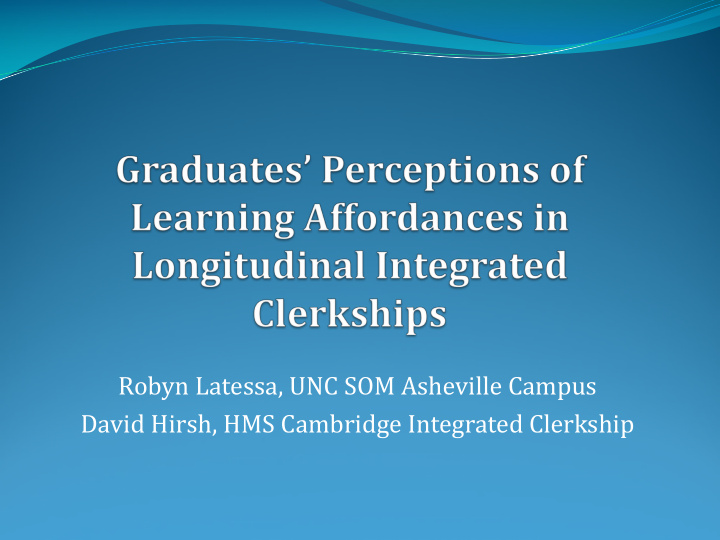



Robyn Latessa, UNC SOM Asheville Campus David Hirsh, HMS Cambridge Integrated Clerkship
Introduction/Background Time to move from “justification research” to “explanatory studies” that investigate the processes that underpin learning in LICs We explored this through learning affordances Qualities of a workplace that promote learning opportunities for the engaged participant
Methods • Subject/Setting Graduates from HMS CIC between 2004-2013 and UNC SOM Asheville LIC between 2009-2013 • Study design Mixed-methods, including survey and interviews • Data analysis Combined the % of participants with high ratings for survey responses, and two researchers without connection to the LIC programs performed the qualitative analysis
Results Response rate 52.6% (60/114) Combined quantitative and qualitative to explore the themes described to have most importance Compiled into a table with subthemes and a figure for schematic representation
Results (Theme and % of quantitative/qualitative responses) Continuity of relationships with preceptors 100/85 Continuity of relationship with patients; 100/65 Flexibility 98/45 Continuity of place 100/30 Continuity of relationships with peer group 92/35 Integrated curriculum /40
Schematic representation of relative importance of LIC learning affordance themes F I P P L N R P P A E T E E L T X E C E A I I G E R C E B R P S E N I A T T L T O S I I R T O S Y N Affordances of Longitudinal Integrated Clerkships
Results (Detail of table for one theme) Continuity of relationships with preceptors 60 (100) 17 (85) Positive role modeling behaviors 59 (98.3) 4 (20) Continuity of relationships with residents 29 (48.3) 3 (15) Continuity of relationships with preceptors 59 (98.3) Faculty teaching 58 (96.7) Meaningful feedback 56 (93.4) Continuity of relationships with specialty physicians 51 (85) Know strengths and weaknesses/set goals/tailored-individualized learning 5 (25) Trust/autonomy/responsibility 5 (25) Ongoing feedback 4 (20) Recognize growth, change, evolution 3 (15) Safe to make mistakes 2 (10)
Results (example of quote in text) “They would give me really honest feedback. Over time their relationships really developed where they knew me more and more as a medical practitioner…They saw me develop and they saw my strengths and weaknesses…And we had more trust, which is something that I think is inherently nonexistent in any short-term, traditional school relationship.”
Discussion Adds to literature about why LICs work, specifically with lens of learning affordances Need to consider applying these themes in other medical education settings Prior to core clinical year in pre-clinical or early clinical experiences Hybrid models in core clinical year Beyond to residency Limitations include only includes LIC graduates’ perceptions and only two institutions
Conclusions LIC graduates’ perspectives suggest what supports student learning in LICs are: Continuity and relationship of the Ps Preceptors, patients, place, and peers Flexibility Integration Further research is needed to understand how these factors support learning, and what other factors may advance of impede learning in LICs
Comments/Questions?
Recommend
More recommend